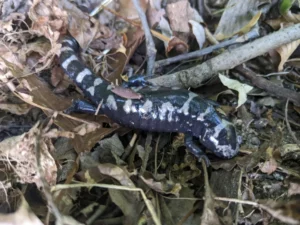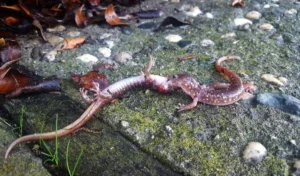Salamanders and newts are quiet, gentle animals that look a lot alike. They have smooth skin, small toes, and slow, careful movements. They don’t make much noise or mess, and they seem to enjoy similar things, such as moist places, live food, and peaceful surroundings. If you like amphibians, it’s easy to wonder if you could keep both in the same tank.
The short answer is no. Even though newts and salamanders are closely related, they don’t usually make good tankmates. Their care needs, behaviors, and habits are just different enough to cause problems, and keeping them together often puts one or both at risk.
Are Newts and Salamanders the Same Thing?
It’s a common question. They look alike, and they share many traits. But they’re not exactly the same.
All newts are salamanders, but not all salamanders are newts. This is kind of similar to how all ravens are birds, not all birds are ravens.

Newts are a subgroup within the salamander family. They tend to be more aquatic, spending most or all of their lives in water.
Other salamanders might live mostly on land, only returning to water to breed, or they might go back and forth depending on the season.
So while newts and salamanders belong to the same family, they can still be quite different. That’s why it’s not enough to say, “they’re related.”
What matters most is how each animal lives, and what it needs to stay healthy.
Different Habits, Different Needs
Even if both animals come from the same family, they might need completely different setups. That’s one of the biggest reasons why shared housing doesn’t work well.
Newts Usually Stay in Water
Many newts prefer to live in water most of the time. They swim, float, and hunt in shallow ponds or slow-moving streams.
Their skin handles constant moisture well, and they’re active swimmers, especially during the breeding season.
Most Salamanders Need Land
Some salamanders, like tiger salamanders or spotted salamanders, live mostly on damp land. They burrow into soil or hide under moss and logs.

Even though they need humidity, they don’t want to be underwater all the time. If you place them in a deep, wet tank built for a newt, they may panic, develop infections, or drown.
Trying to keep one tank that suits both often leaves one struggling to survive.
Territorial Behavior and Stress
You might think that amphibians are too quiet and slow to cause trouble. But they do interact, and not always in friendly ways.
Some Newts Nip
Newts are small, but they’re not always peaceful. Some are quick to nip at other animals during feeding time or when exploring the tank.
This can lead to torn limbs, missing toes, or skin damage, especially for salamanders with softer bodies.
Salamanders May Fight Back
Salamanders can also be territorial. They often claim hiding spots or favorite corners of the tank. If they feel crowded or threatened, they may lash out, especially if they’re larger than the newt.

Even if the animals are the same size, they may still compete for space. In a small tank, there’s nowhere to escape, and tension builds fast. Constant stress makes both animals more vulnerable to illness and injury.
Feeding Time Gets Complicated
Feeding two different species in the same space may seem simple at first. After all, they eat the same things, worms, crickets, small insects. But problems show up quickly.
Someone Always Eats More
If one animal is quicker or more aggressive at feeding, it may take most of the food. The other animal might not get enough. Over time, this leads to uneven growth, weakness, and malnutrition.
Competition Makes Things Worse
Feeding time can also bring out defensive behavior. If both animals go after the same worm or cricket, one might bite the other by mistake.
That kind of injury is common in mixed-species tanks, especially when food is limited.
You can’t explain to a hungry newt or salamander that there’s more food coming. They just react. And those reactions often cause harm.
Illness Spreads Fast Between Species
Even closely related amphibians can carry very different bacteria, parasites, or skin fungi. Sometimes these infections don’t affect the host animal, but they can be deadly to a tank mate.
Shared Water Means Shared Risks
Both animals soak up everything around them through their skin.
If the water has bacteria or fungus, it enters their bodies directly. And since they’re in the same tank, there’s no way to protect one without protecting the other.
Some Pathogens Are Species-Specific
Chytrid fungus, for example, affects many amphibians, but it doesn’t always show up the same way in every species.
One animal might look fine while the other slowly gets sick. By the time you notice symptoms, it could be too late.
Keeping species apart helps you stop a problem before it spreads.
Environmental Needs Don’t Line Up
It’s not just about water and food. Newts and salamanders often need different things in almost every part of their care.
One might like cooler temperatures. The other needs it a bit warmer. One prefers dim lighting.
The other likes a little more daylight. One hides all day. The other swims at night. Even their favorite humidity levels may not match.
Trying to balance all of that in a single setup usually means compromise. But with amphibians, compromise can mean illness.
If the tank isn’t just right, they get stressed. And stressed animals get sick.
But What If They’re the Same Size?
Size might seem like a good reason to keep them together. If they’re close in weight and length, you might assume they’ll leave each other alone. But size doesn’t stop:
- Constant stress
- Fighting over food or space
- Accidental injuries
- Spreading disease
You might get lucky at first. But things can change overnight. Amphibians don’t give clear warnings. They don’t growl or hiss.
They just hide more, stop eating, or start acting oddly. And by the time you notice, real harm may already be done.
A Safer Way to Enjoy Both
If you love salamanders and newts, the best thing you can do is keep them in separate tanks. This gives you total control over their care. You can:
- Keep temperatures and humidity at the right levels
- Feed each animal without competition
- Clean their tanks properly
- Spot illness early
You can even decorate the tanks similarly if you like the look. Or place them next to each other so you can enjoy both animals at once.
You’ll get the best of both worlds, without any risk.
Conclusion
Salamanders and newts have a lot in common. They’re both amphibians. They both need moisture, live food, and quiet spaces.
But those similarities aren’t enough to make them good roommates.
They have different needs, different habits, and different responses to stress and sickness. In most cases, trying to house them together creates more problems than it solves.
To give each one a healthy, peaceful life, it’s best to keep them apart. They won’t be lonely, and you’ll be able to care for them properly.
When it comes to amphibians, separate spaces are always safer.
Hi, my name is Ezra Mushala, i have been interested animals all my life. I am the main author and editor here at snakeinformer.com.

